Authored by Mukherjee, A.*1, Bier, R.2, Omondi, E.1, Kan, J.2, Daniels, M.2
Introduction
As of 2011, organic farming was being practiced in 162 countries around the world using only 0.86%, or, 37.2 million hectares of farmland (FiBL 2016). Each farming decision has the potential to influence soil quality and organic farming practices are no exception. For example, organically managed soils usually have higher soil organic matter (SOM), pH, soil organic carbon (SOC), and soil-nitrogen (SON), macro, and micro nutrients, biological activity, and lower compaction and bulk density (BD) compared to conventionally managed soils (Sheoran et al. 2019; Lori et al. 2017; Das et al. 2017; Reganold, Elliott, and Unger 1987). A number of past studies indicated that organic agriculture can improve soil physicochemical parameters under both short, and long-term experiments, and across vast geographical areas. Some studies also indicated that organic management could have greater crop yield in weather-challenged conditions such as drought or nutrient depleted areas when compared to conventional farming primarily due to significantly improved soil condition (Pimentel et al. 2005). Additionally, organic farming may also influence the environmental impacts of agriculture when compared to traditional conventional farming (Tuomisto et al. 2012a; Puech et al. 2014; Lee et al. 2015). For example, a recent meta-analysis using 107 studies, and 360 observations published from 1977-2012 suggests significantly improved energy efficiency and reduction in greenhouse gas (GHG) emissions were associated with organic than conventional farming (Lee, Choe, and Park 2015). Another meta-analysis conducted using 71 studies from Europe shows that organic farms had higher SOM, and lower nutrient losses through leaching (nitrogen) and gaseous emissions (nitrous oxide, and ammonia) per unit of field and lower energy requirements. However, this analysis also reveals that organic systems had higher land-use, eutrophication, and acidification potential than conventional systems (Tuomisto et al. 2012b).
Project Details
The Delaware River Watershed (DRW) (about 13,500 mi2) provides clean drinking water for about 5% of the U.S. population and is a major recreational and industrial area for residents of New York (NY), New Jersey (NJ), Pennsylvania (PA), and Delaware (DE) with an annual economic value of $25 billion. Rodale Institute and Stroud Water Research Center have begun a long-term research, education, and outreach project, called Watershed Impact Trial (WIT), over a 6-year period, starting in 2018 aimed at addressing the barriers to adopting water conservation farming practices. This project will produce a paradigm shift in how the 15 million people who rely on the DRW view water and agriculture, and how farmers manage their land to build resilience and reduce negative impacts on ecosystems. Clean water is tied to healthy soil because soils act as natural filtration systems to remove contaminants before the water reaches waterways or aquifers. Healthy soils are tied directly to the foods they produce and consumer choice impacts both soil and water. This project is funded by the William Penn Foundation as part of their continued commitment to improve the quality of the DRW.
This collaborative work under WIT focuses on how enhancing soil health can influence freshwater quantity and quality in the DRW under organic, conservation, and conventional management practices. Healthy soils and their associated ecosystems promote water infiltration and storage of rainwater and help minimize contaminants (sediments, nutrients, and pesticides) in underground aquifers and surface waterways that support humans and wildlife in the DRW. For nearly 40 years, Farming Systems Trial (FST) at Rodale Institute has been comparing two organic (legume and manure) systems, and one conventional farming system with and without tillage (no-tillage introduced in 2008). Data on soil health parameters, crop yields, profit, energy input, and carbon sequestration have revealed organic agriculture has higher profits, lower energy inputs, enhanced soil health, and less carbon emissions (Pimental et al., 2005). Rodale Institute and Stroud Water Research Center scientists matched four studied organic, and conventional systems of FST at the Stroud Preserve in West Chester, PA that compares conventional tilled, conservation no-till, organic tilled, and organic no-till managements under corn/soybean systems. Thus, research plots were established at Stroud Preserve to match four FST treatments testing the impacts of different grain production strategies on soil health and water quality. The main difference between two studied locations is 0-3% slope at FST compared to up to 15% slope at the Stroud preserve plots (Figure 1). Agronomic, soil health, and water quality parameters are being assessed over the entire six years of the study to fully account for annual climatic fluctuations, and measured changes in soil.

Methods
Soil samples were collected by deep soil coring method using the Giddings Probe from 0-10, 10-20, 20-30, 30-60, and 60-100 cm depths in January 2019. Five random soil samples were collected from each plot, four samples were cut, and homogenized by depth to represent a single system/treatment, and one full length soil core was set aside for bulk density measurement. These homogenized or, mixed representative samples were sent to the soil analysis labs of Pennsylvania State University (PSU), and Cornell University for a number of soil chemical, and biological analyses including SOM, SOC, soil N, pH, soil macro-, and micro-nutrients, permanganate oxidizable C, soil respiration, soil protein, and potential mineralizable N.

Soil physical parameters that are being studied include bulk density, soil aggregate stability, penetration resistance as soil compaction, and soil infiltration. Soil compaction was determined using penetrometer (Figure 3A) in the root zone using 300 pounds per square inch (psi) as the threshold penetration resistance of the soil because most crop roots cannot easily penetrate soil above 300 psi penetrometer readings. Soil water infiltration was determined using double ring infiltrometer process (Figure 3B). Both of these soil field tests were performed in the spring, and summer of 2019.
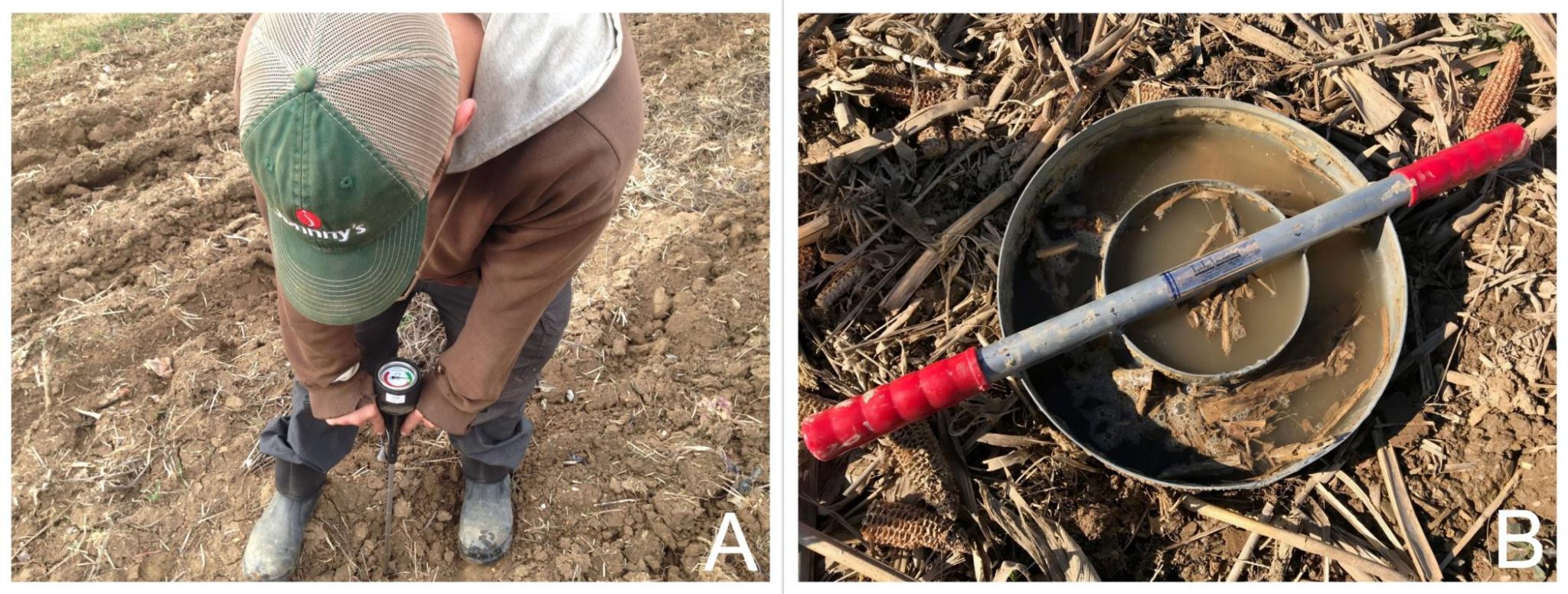
Soil pore water was sampled from installed (at 100 cm) deep passive (Figure 4A), and active lysimeters (or, suction cup lysimeters, or, water samplers installed at 15, 30, and 45 cm depths) (Figure 4B). The soil porewater leachate samples are being collected from deep lysimeters two to three times a year, while the soil porewater samples using suction cup lysimeters are being collected two times a year after a heavy rainfall event. While the passive lysimeters collect porewater samples that have been stored in a large container for 3-4 months prior collection, the active lysimeters are designed to collect soil porewater samples at the specific time of the year. Thus, the porewater samples collected from passive lysimeters are representative of cumulative water biology, and chemistry, while the water samples collected by active lysimeters reflect quality of recently percolated porewater after a heavy rainfall.
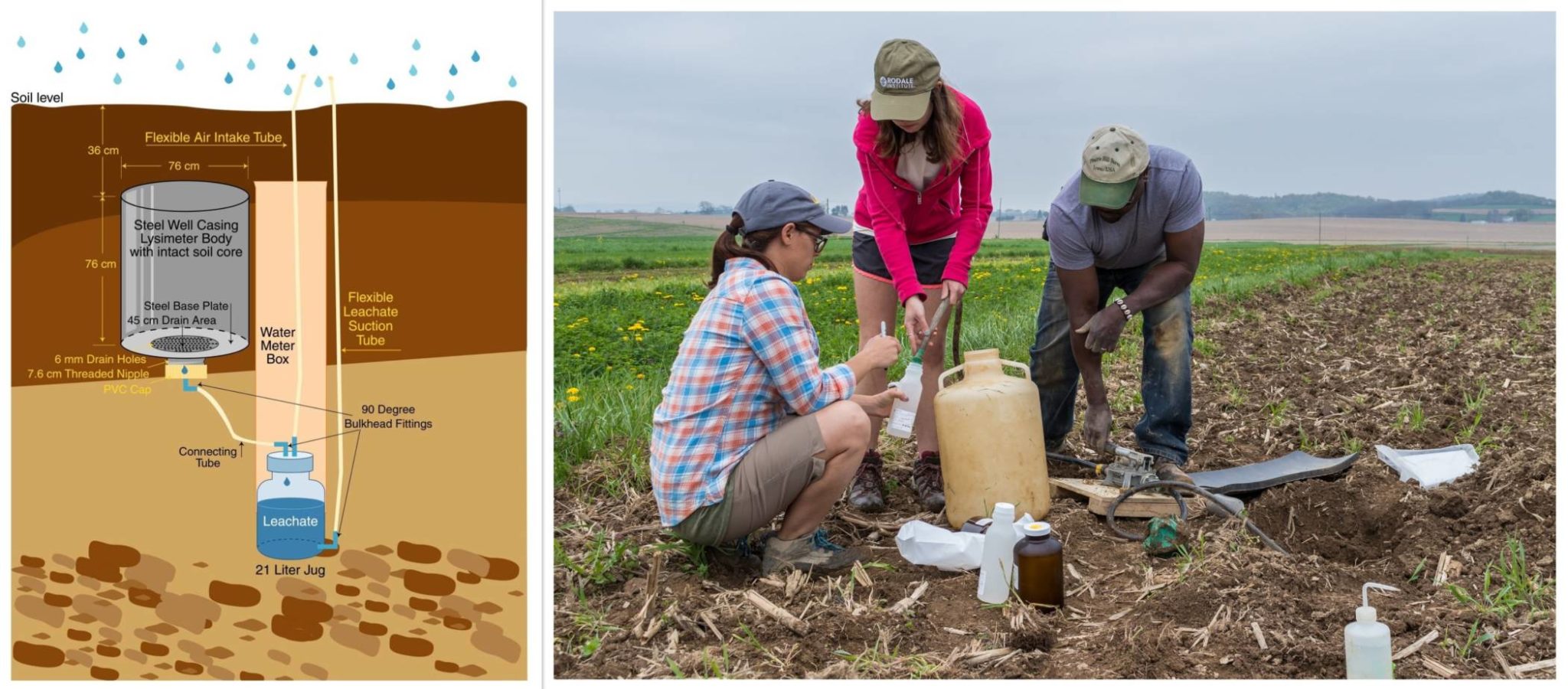
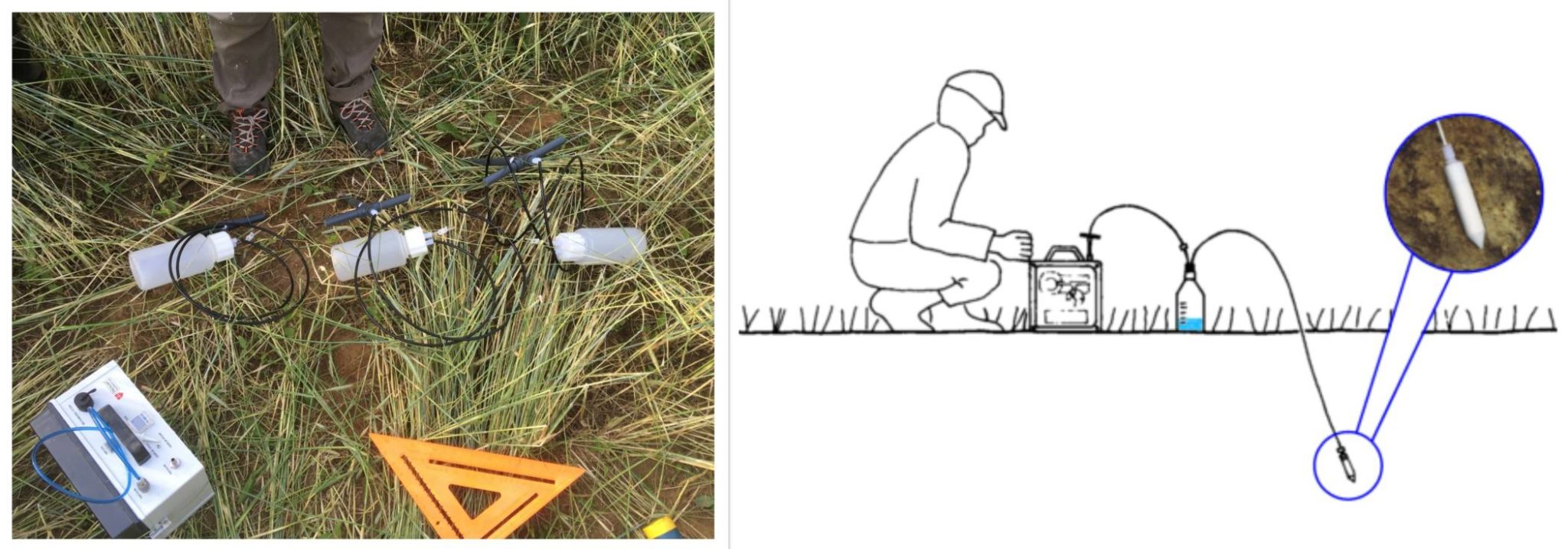
Results
This web article presents preliminary research results on soil health, and water quality from the soil, and water samples collected from FST location only as the Stroud Preserve’s data are premature to produce any significant differences under contrasting management practices due to very recent establishment of the research plots (established in 2018). Due to very wet weather condition during soil sampling at initial baseline 2018/2019 (January, 2019) sampling timeframe, the top (0-20 cm) soil’s characteristics were not typical representatives of the FST systems as documented in the past (see section “Long-term tradition at FST”), thus only few most important soil parameters from 2019 baseline soil sampling are shown here.
Long-term tradition at FST
Long-term data on SOM, SOC, soil N, and pH (soil reaction) of the surface soil (0-20 cm) indicate that from the beginning (1981) of the study at FST, although SOM has been increasing under organic (both legume, and manure) and conventional system, but SOM level increased by 17% over time under the organic than conventional system (Figure 5). Rotational No-tillage (NT) practice was introduced in the long-term tilled plots at FST in 2008, however, except in few cases tillage did not show any significant differences under organic, and conventional management systems among the tested soil health parameters. Thus, although no-tillage was established in 2008, the data from tilled, and no-tilled plots were averaged to get a representative analysis by system only (Figure 5).
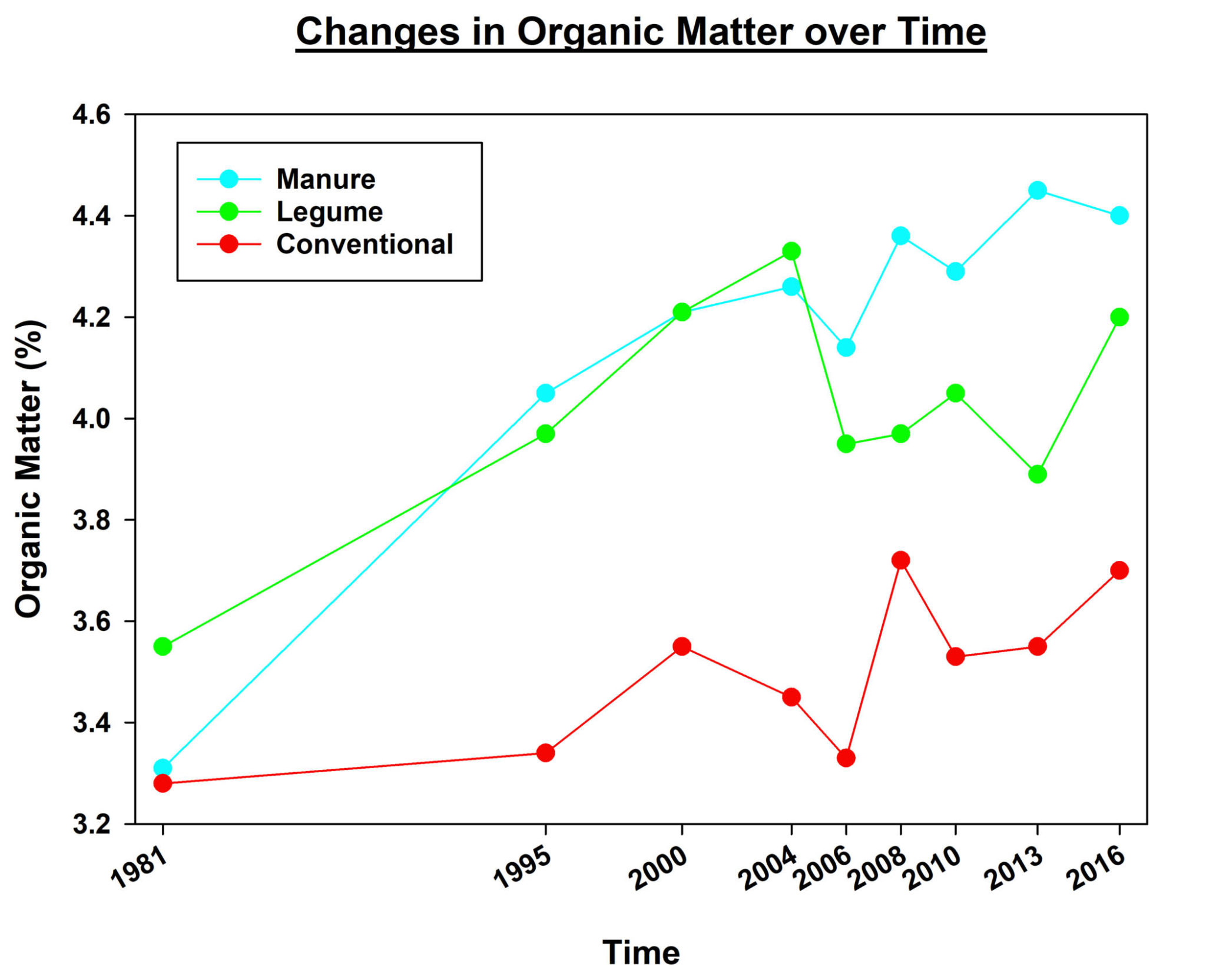
An analysis of the past 10-year soil health data from FST also indicates that SOC, and soil N were significantly increased under compost, and legume systems compared to conventional system, while the soil pH was significantly higher under conventional, and compost system compared to legume system (Figure 6). However, all three systems had soil pH within 6-7 range, which is not critically damaging for plant nutrients availability. The significant increase in SOC, and soil-N under both legume, and compost systems suggest that higher input of organic compost, and legume biomass on topsoil over long-term is beneficial for retaining SOM, and possibly sequester SOC, and soil-N under organic systems. These long-term data on soil health under various systems at FST indicate that crop production under organic systems can improve soil health over time, and thus become basis for initiating the proposed study in 2018 at FST, and Stroud Preserve to test if soil health, and water quality improve under various farming practices in organic, and conventional grain cropping systems in Pennsylvania.
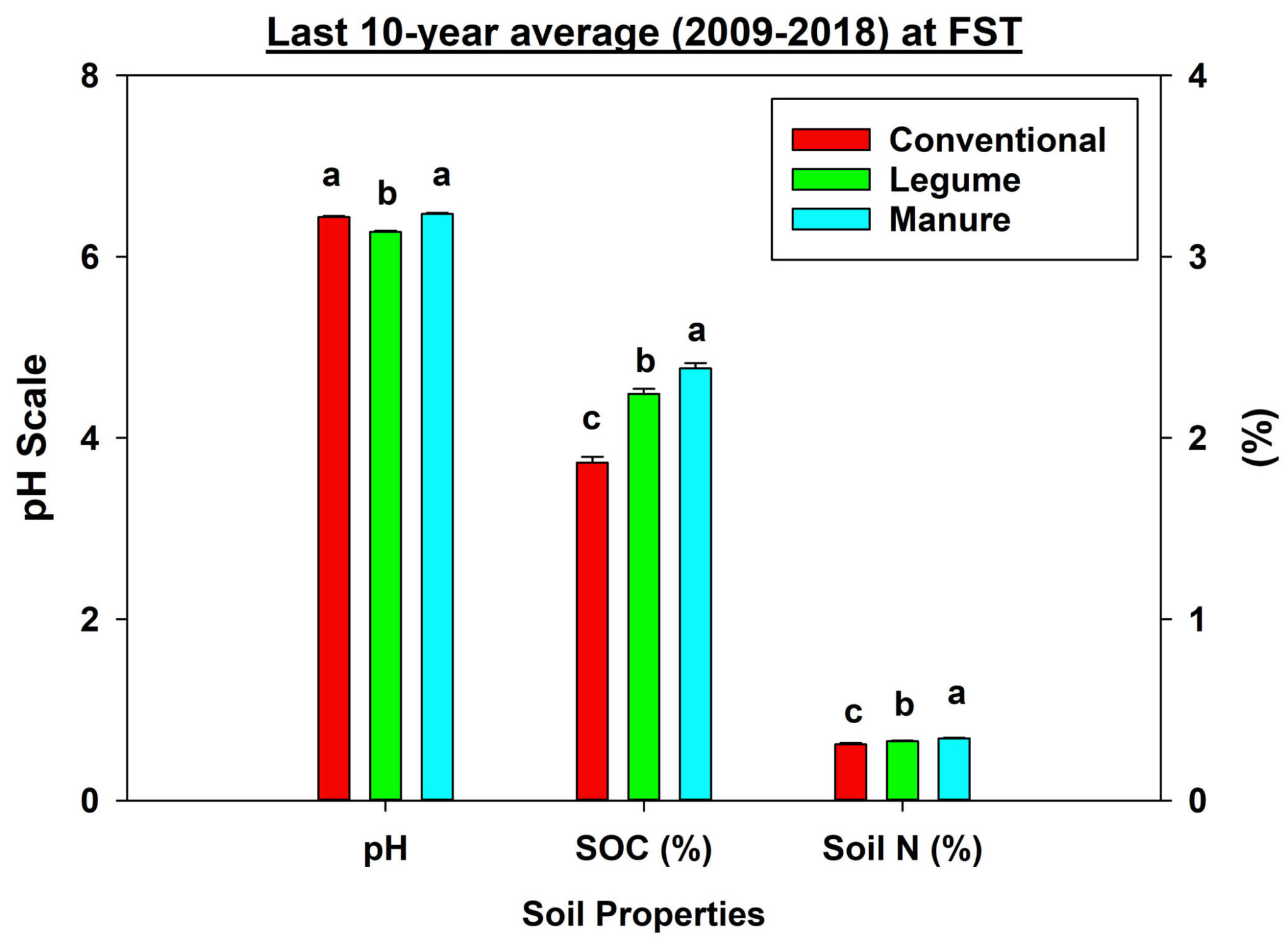
Baseline soil health parameters under organic and conventional systems at FST
The preliminary results of soil health at FST location show that SOM, SOC, and soil N (Figure 7), were not significantly different between farming practices, especially on the top (up to 30 cm) soil surface (30-60 cm, and 60-90 cm data are not shown), and this is in contrast to the traditional FST results on these soil parameters (Figures 5 and 6). This inconsistency may be attributed to significantly wet condition of the soil during sampling in January 2019 that may have impacted some soil health parameters, especially at the topsoil level. However, other field measurements that took place in late spring, or, summer in 2019 when the fields’ wet situation improved show enhancement of soil health. For example, on average, soil compaction was significantly decreased by 17% (Figure 8), and soil infiltration was significantly increased by 3.4 times (Figure 9) under long term organic compared to conventional management practices at FST. This significant decrease in soil compaction, and increase in soil water infiltration under organic systems at FST indicates the profound influence of high SOM under organically managed plots (Figure 5), and possibly higher activities of earthworms and resulting macropores. In addition, higher soil water infiltration can minimize water logging, and surface runoff conditions that lead to soil erosion.
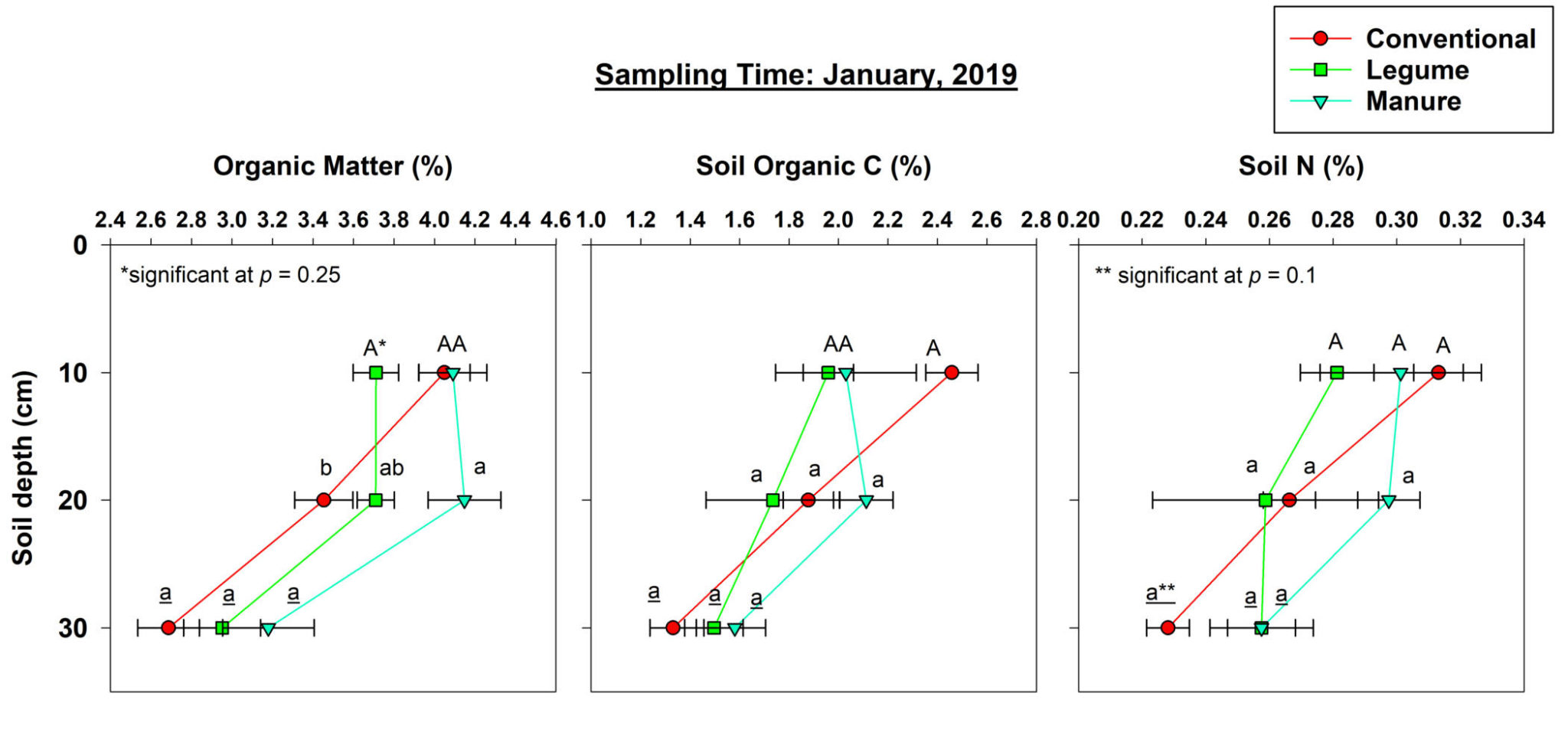
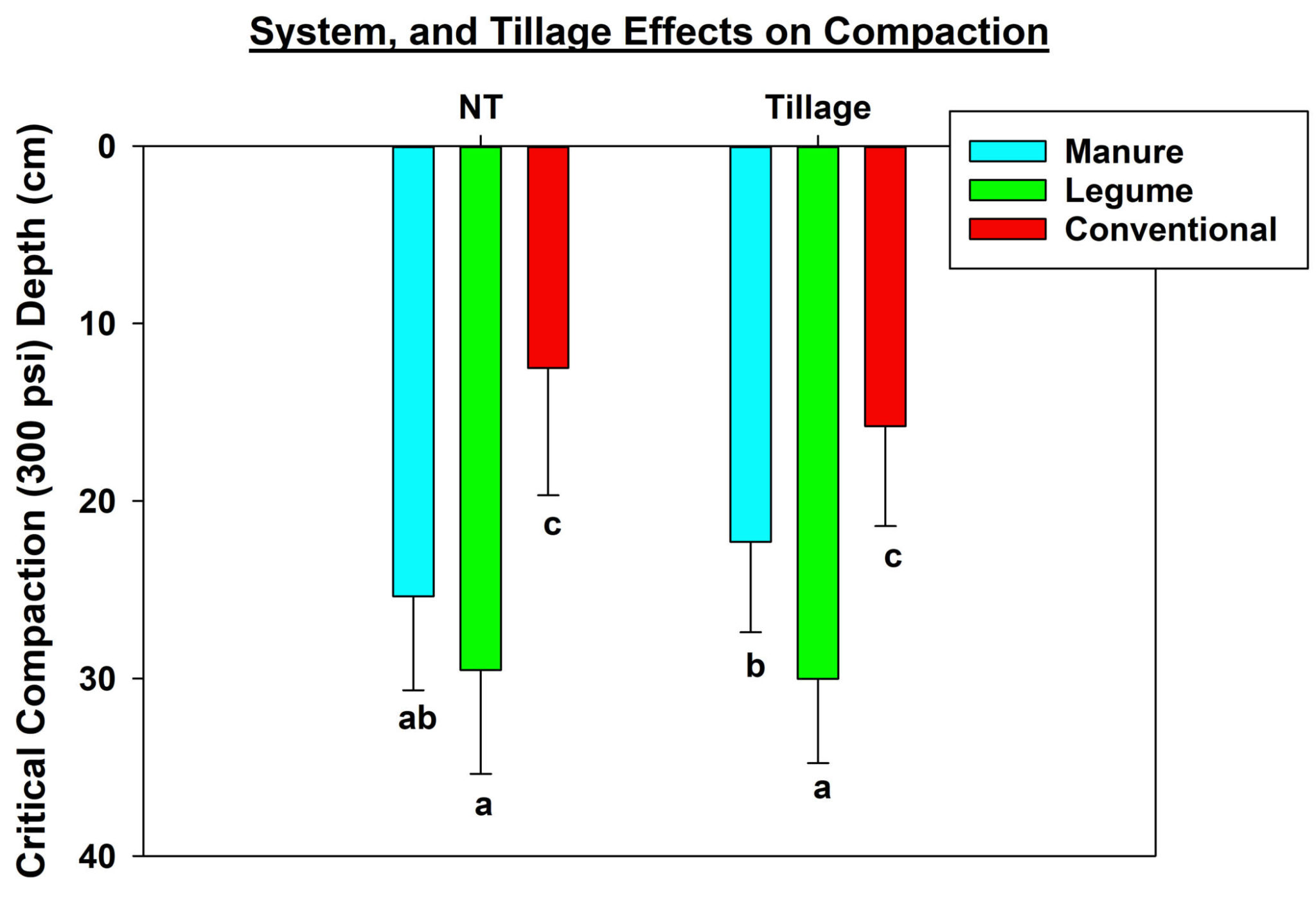
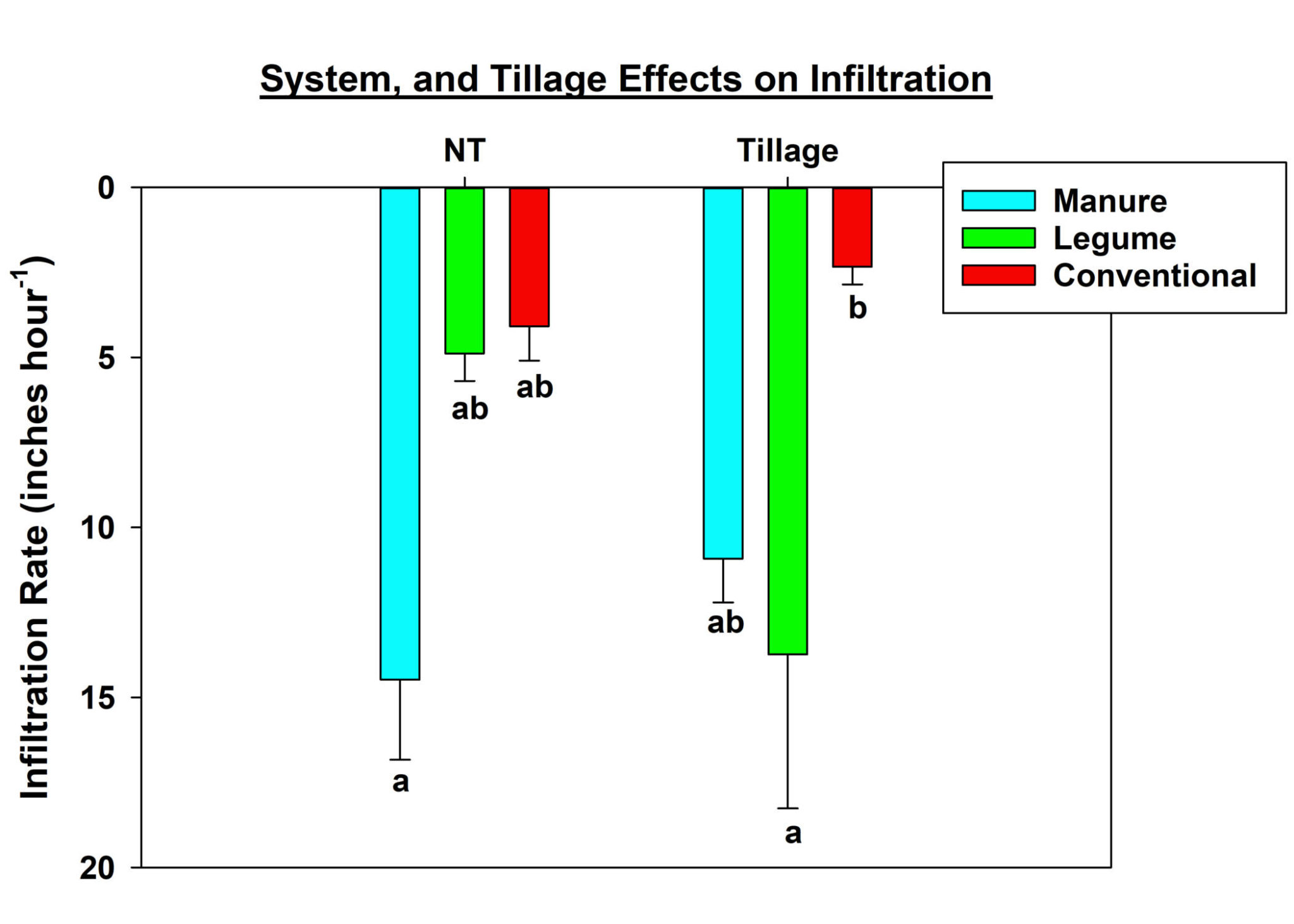
Baseline water quality parameters under organic and conventional systems at FST
Various water quality parameters were measured from passive and suction cup lysimeters (water samplers) installed at different depths at the FST location as described in the ‘Methods” section (biological data are not reported here). The passive lysimeter data are not reported here due to cumulative nature of the nutrients dynamics that may not directly reflect the “real time” water quality under various systems.
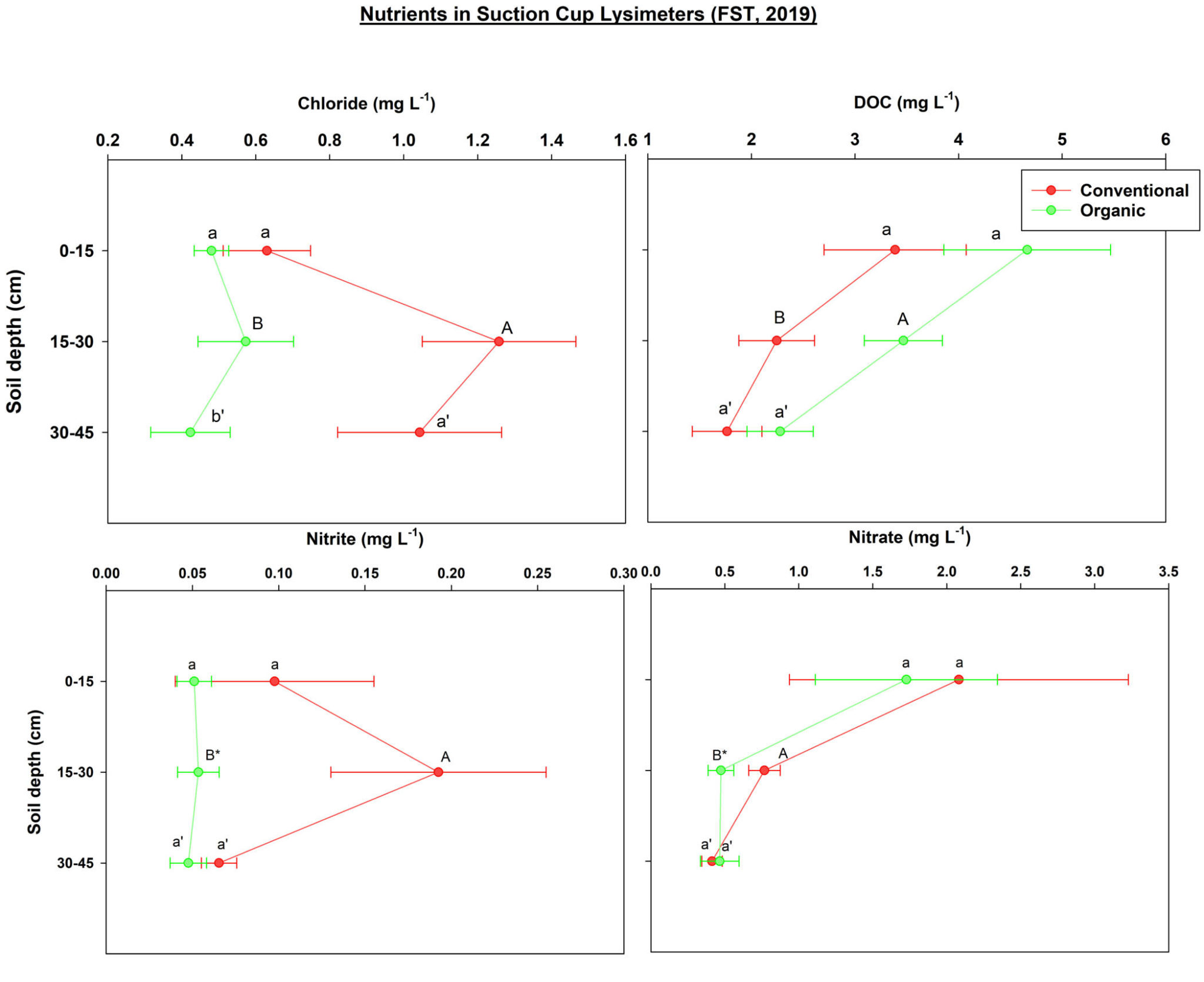
Water samples collected from active (suction cup) lysimeters indicated that chloride, nitrite-N, and nitrate-N were percolated out at higher concentrations under conventional than organic systems, while the opposite pattern occurred with dissolved organic C (DOC) and sulfate (data not shown) concentrations (Figure 10). While concentrations of leached chloride, nitrite-N, and nitrate-N were significantly higher under conventional than organic systems, the volume of water that leached is necessary to understand the total amount of each chemical percolating from a given area. In contrast, DOC concentrations were lower in the conventional plots relative to the organic plots. This is likely the result of increased SOM in the organic soils. Thus, collectively these results suggest that the conventional systems are leaching significantly lower concentrations of DOC and higher concentrations of nitrite-N, nitrate-N, and total N (data from passive lysimeters not shown) compared to studied organic systems, likely reflecting differences in the amount and type of fertilizer input and retention in the soils as well as differences in the volume and retention times of soil pore water.
Summary
This report provides initial results of the collaborative study (WIT) started in 2018 using a long-term studied location (FST), and a recently established location (Stroud Preserve) in order to get insights of soil health, and consequent water quality under various agronomic management practices for row crop production. Initial results suggest that soil compaction and infiltration were significantly improved by long-term organic management practices as a direct result of significantly higher SOM under organic compared to conventional system. The trend of continuous soil health improvement under long-term organically managed plots at FST was only partially observed due to very saturated or, wet condition during the initial baseline soil sampling in January 2019 that affected soil physicochemical properties at the topsoil. In remedy, 0-10, 10-20, and 20-30 cm soils were resampled in October, and November of 2019 from both studied locations, and all these soil tests were repeated to make a comparison with the initial data.
Soil porewater may percolate through deeper soil profile before reaching the groundwater, and thus even more filtration by the soil profile is expected. Significantly higher nitrite-N, nitrate-N, and total N concentrations (data not shown) in soil porewater samples under conventional compared to organic system were observed, and these systems will continue to be evaluated over different parts of the growing season and with respect to total volumes leached to understand total loss of these compounds below the rooting zone. Long-term data from collected water samples on all these chemicals groups at multiple sampling points over the course of this project will depict a sound picture of the overall biogeochemistry of the studied nutrients.
________________________________________________________________
Glossary:
DOC: Dissolved Organic Carbon
FST: Farming Systems Trial at Rodale Institute
N: Nitrogen
SOC: Soil Organic Carbon
SOM: Soil Organic Matter
WIT: Watershed Impact Trial
________________________________________________________________
This material is based upon work supported by the William Penn Foundation under Grant Award Number 188-17. The opinions expressed in this publication are those of the authors and do not necessarily reflect the views of the William Penn Foundation. The authors would also like to thank all the research technicians, and interns of both Rodale Institute, and Stroud Water Research Center for assisting in various activities in the fields, and labs.
